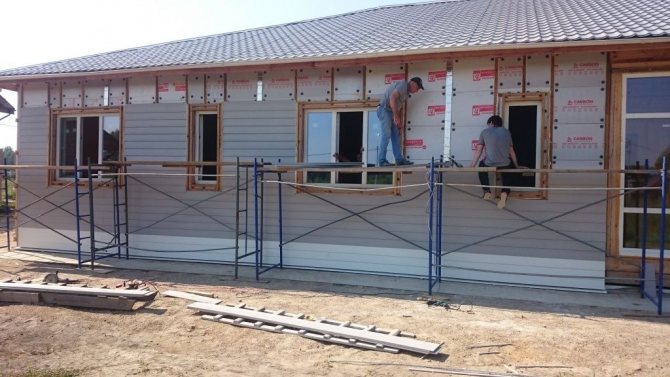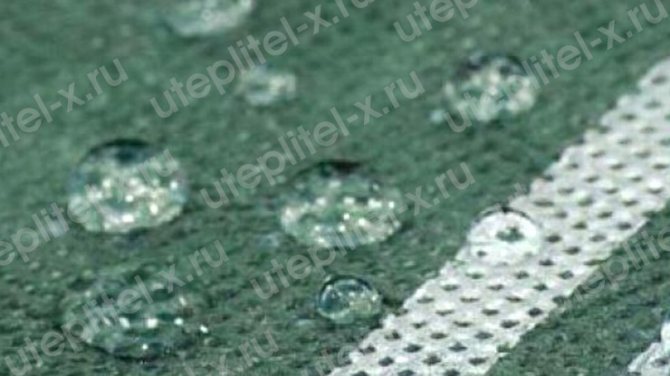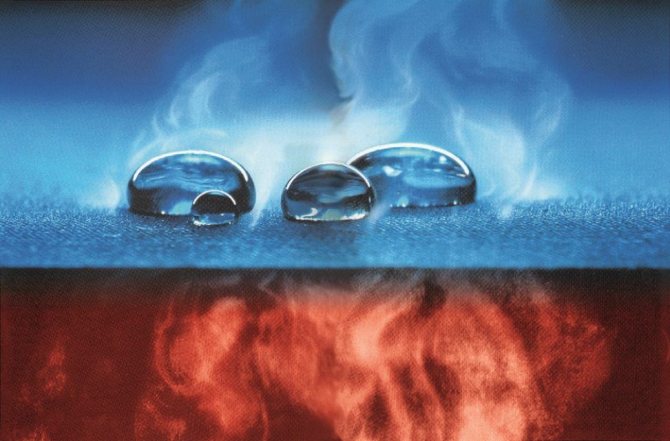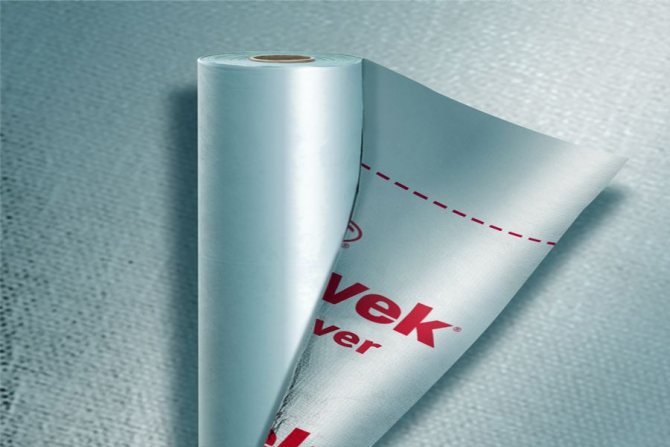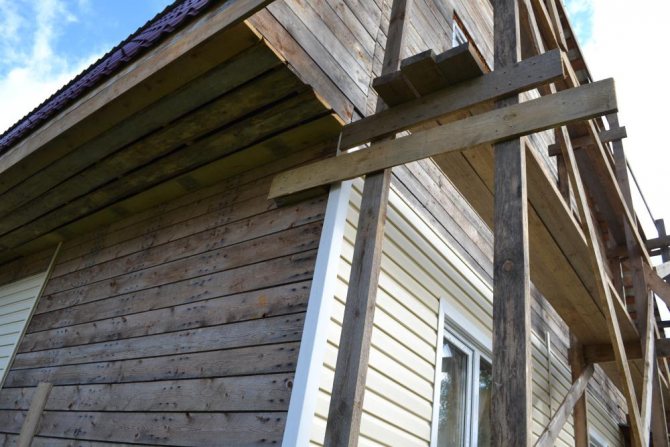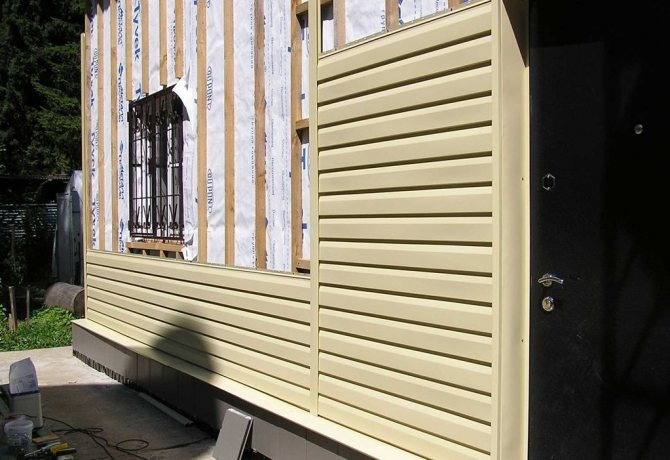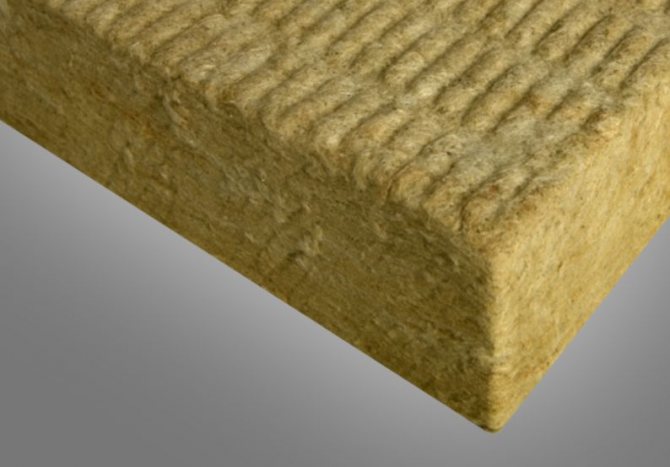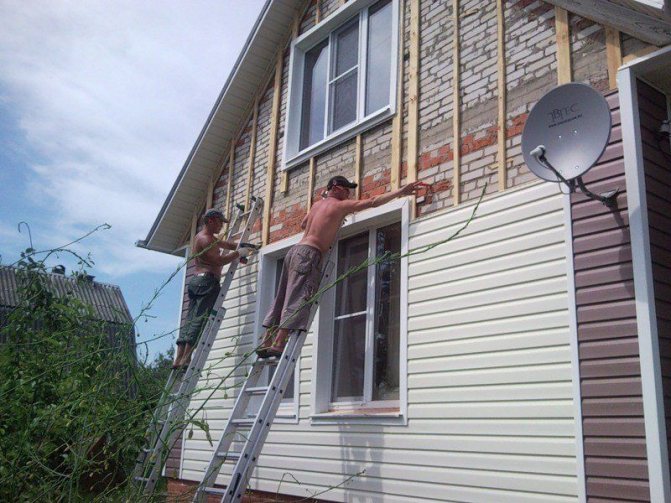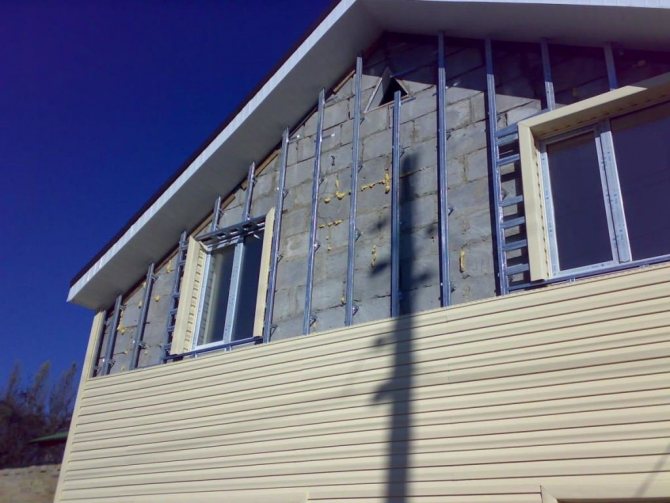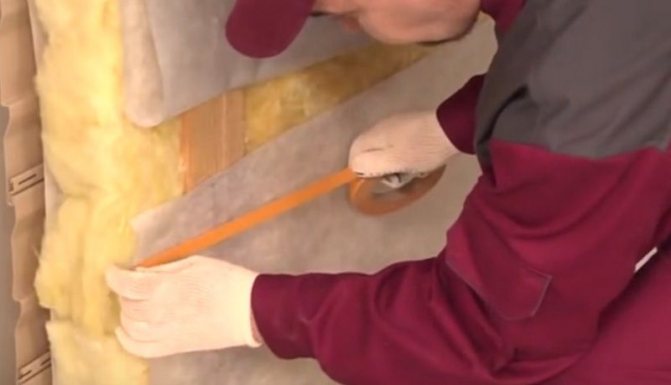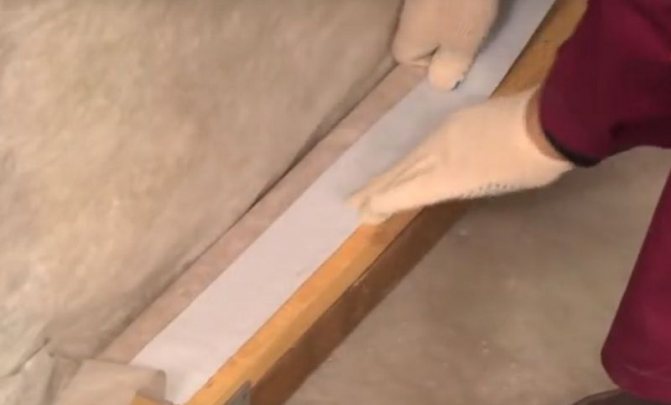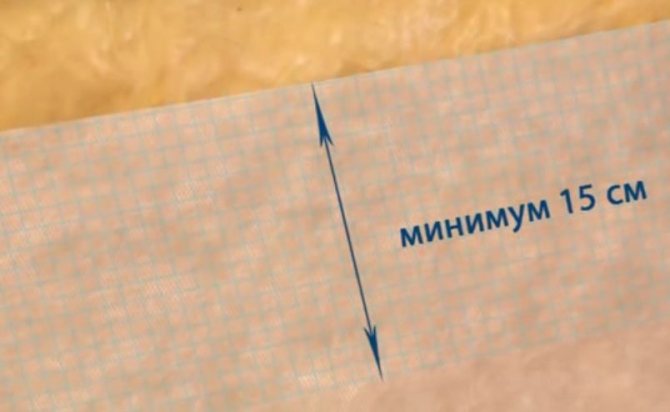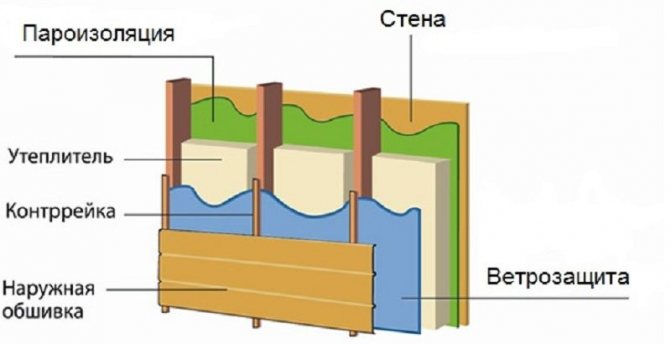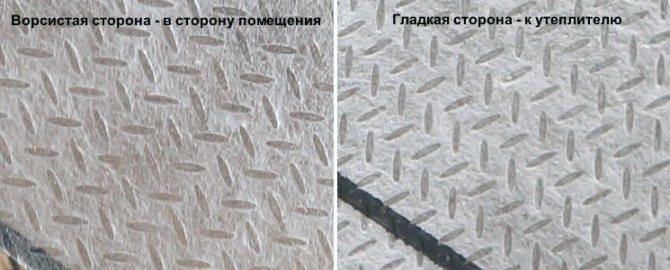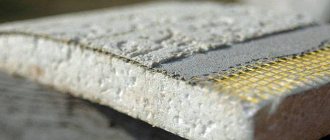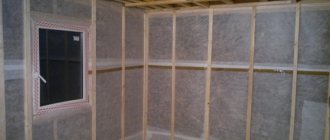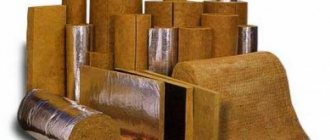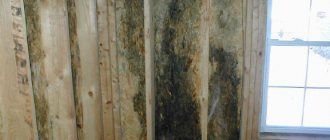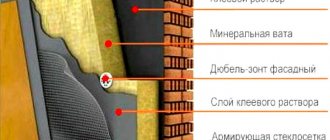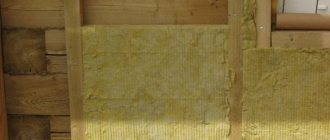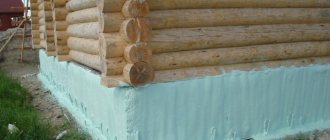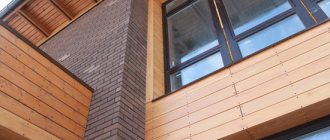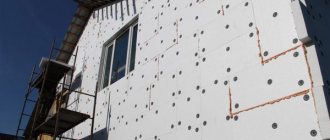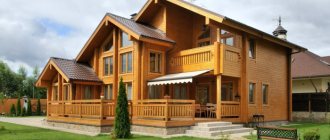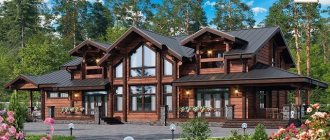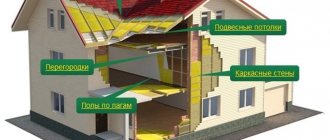Ebb and flow
Waterproofing
Insulation
Corrugated board
Euroshtaketnik
Gutter
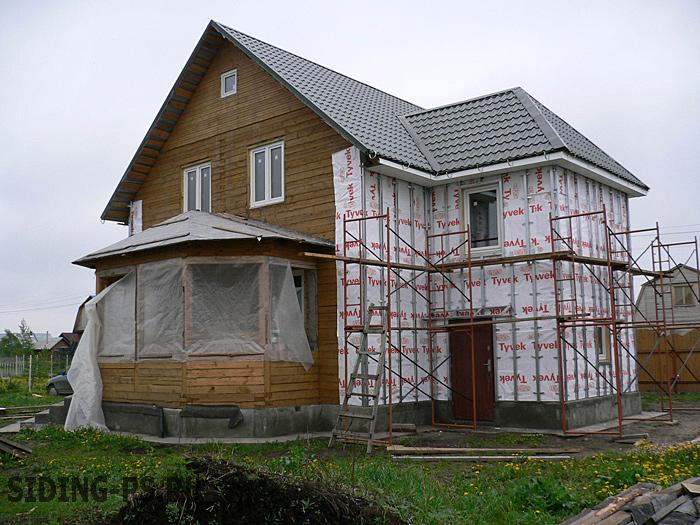
Under the word waterproofing often understood as vapor barrier and waterproofing films. All of them protect the insulation of walls and structures from moisture. When installing siding, both types of films are used or only waterproofing films - this depends on the construction of the walls of the house.
Competent installation of siding involves the use of lathing. It helps level walls when unevenness is present and makes installation easier. In this case, there is free space between the siding and the wall. Additional insulation is placed in this particular space.
Why waterproofing is performed ↑
Before sheathing the walls with siding, the sheathing is being installed. A waterproofing film is attached to it from the inside.
A free space is formed between the wall and the siding, which is usually filled with insulation. Despite the fact that vinyl (the material from which the siding is made) is waterproof, the lining is not airtight: air freely penetrates between the panels and the moisture contained in it permeates the insulation. Mineral wool and glass wool, which are most often used to fill the walls, are not afraid of open fire, have a low specific gravity and do an excellent job with their main function of insulation. But, being saturated with moisture, they lose their qualities and become deformed. Wall materials also suffer: drywall swells, wallpaper molds. There is a threat to the safe operation of electrical networks.
How does the protective layer "work"
The task of waterproofing materials is to create a moisture barrier in the form of precipitation and vapors contained in the air. Snow, which is packed under the ridge of the roof, subsequently melts and flows down the surface of the waterproofing film to the ebb of the foundation, and from there into the drainage system. In the absence of this film, moisture would have entered the thermal insulation material.
The same problem occurs with walls. Despite the fact that the siding panels are mounted with an overlap, in case of strong winds, rainwater still gets under the cladding through the cracks. If waterproofing is present, moisture flows down without damaging the structure. Therefore, the external decoration of the building requires a ventilation gap of 20-30 mm for laying the insulating material.
The main difference between a high-quality waterproofing film is its ability to retain moisture, but at the same time not interfere with the natural ventilation of the walls: the film is a membrane and therefore steam can freely pass through the walls, which means that the house will "breathe".
When choosing an insulating material, you should pay attention to the fact that the moisture resistance of each type of film is different: it is assessed by the ability of a unit of area to withstand a certain volume of water without leaks, as well as by the amount of steam passed during the day. The cost of films is also different: it depends on their quality and basic characteristics. The larger the column of water the film can withstand (and let steam through in a large volume), the more expensive it will be. This is explained by the multilayer nature of such material, but a cheaper option is enough for laying under siding.
How to properly protect the house from moisture and steam?
In most regions of Russia, a house needs insulation, and therefore a vapor barrier. The correct moisture protection technology in this case resembles a puff cake and looks like this:
Layer 1. Vapor barrier.
The vapor barrier film is attached directly to the wall of the house.For high-quality protection of the insulation, it is mounted with an overlap. By the way, modern vapor barrier films are made according to the principle of a membrane: steam does not penetrate into the insulation, but at the same time it can be removed from it. When using such material, it is important to lay it on the right side.
Layer 2. Insulation.
Insulation is installed on the vapor barrier film. The detailed technology of its installation with siding crate can be found in the instructions on our website. We especially note that it is important to avoid cold bridges.
Layer 3. Wind protection.
To protect the insulation from moisture during rains and snowfalls, wind and moisture protection is installed on top of it.
Layer 4. Ventilation gap.
To prevent stagnation of moisture under the finish, there must be a ventilation gap between the panels and the insulation. Free circulating air facilitates the evaporation of moisture and prevents the formation of fungi.
Layer 5. Siding or facade panels.
The final stage is the installation of siding or facade panels. The technology of their installation is described in detail in the instructions. By the way, if you have not yet chosen which siding to use for finishing your home, take a look at our catalog. In it you will find a huge selection of finishing materials. You can try them on at your home in the Alta-Planner online program. It's easy to do - the result is very clear!
The cake is ready. The insulation is protected from moisture on all sides and will keep warm even in the harsh winter.
www.alta-profil.ru
Basic rules for waterproofing
When installing a waterproofing film, certain rules must be observed:
- When laying the film, the edges should be joined with an overlap of at least 150 mm, gluing the joint with tape. In this case, it is necessary to check the absence of areas not covered with waterproofing in order to avoid the insulation getting wet.
- The film should be fixed in such a way that it cannot be damaged during the installation of the siding.
- The foil is fixed with galvanized wide-headed nails or with staples using a mechanical stapler.
- A gap of about 30 mm is required between the film and the siding in order for natural ventilation to take place. In addition, when installing some types of films, it is required to leave a gap between them and the insulation: this requirement should be indicated in the instructions from the manufacturer.
- It is required to monitor the correct orientation of the film: if you put it on the wrong side, the material will not function correctly.
The order of work when insulating a house
The ventilated facade insulation system looks like this in layers:
- Wall.
- Vapor barrier.
- Insulation.
- Waterproof and windproof membrane.
- Ventilated gap.
- Siding curtain facade.
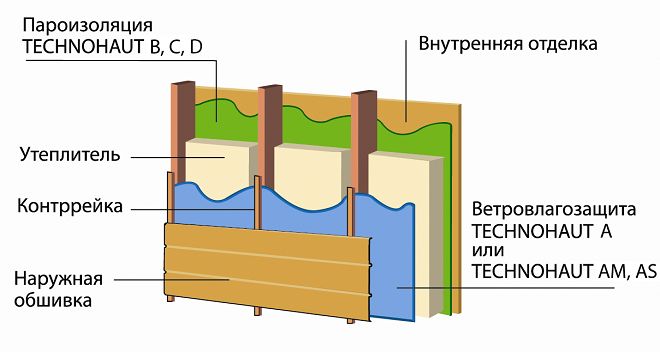

The curtain wall is attached to a metal frame if the siding is metal or heavy, such as fiber cement or ceramic plinth siding. When insulating wooden log cabins, most often the supporting frame is made of wood.
Installation of vapor barrier film on the wall of the house
After preparing the facade - cleaning it from dirt, treating wood, impregnating it with a fire retardant and antiseptic, we attach a vapor barrier strip or membrane.
The vapor barrier is attached to the wall using a construction stapler. The vapor barrier panels are glued together with a vapor-proof double-sided tape with an overlap of 10-15 cm, all edges are glued with tape. The bottom edge of the vapor barrier must lie on the starting (basement) profile.
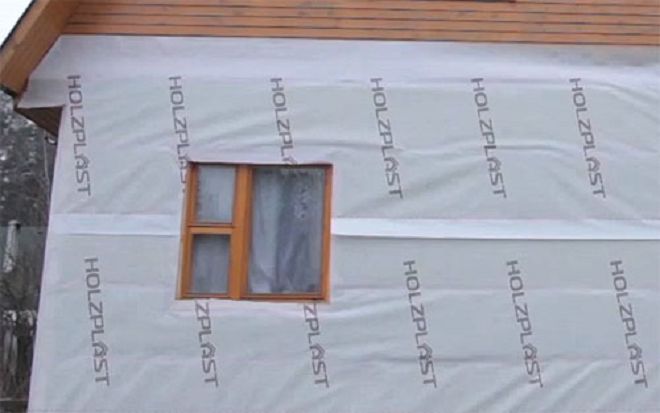

Installation of insulation over vapor barrier
A frame system made of timber with a thickness equal to the thickness of the insulation layer, 40 mm wide is mounted on nails or dowel screws. The step of the frame racks is equal to the width of the insulation plate minus 5 mm per spacer.The installation of the heat insulator is carried out on disc-shaped dowel screws with a metal core (fungus) at the rate of 5-6 pcs / m2.
Installation of windproofing (wind protection and moisture protection) over the insulation
Fastening of the moisture-windproof membrane is also performed with a stapler to the insulation and the frame racks, with laying the panels with an overlap of 15 cm and fastening with double-sided vapor-proof tape. The lower edge of the membrane is lowered 2 cm below the level of the basement strip to drain the condensate onto the blind area. All edges are also glued with tape.
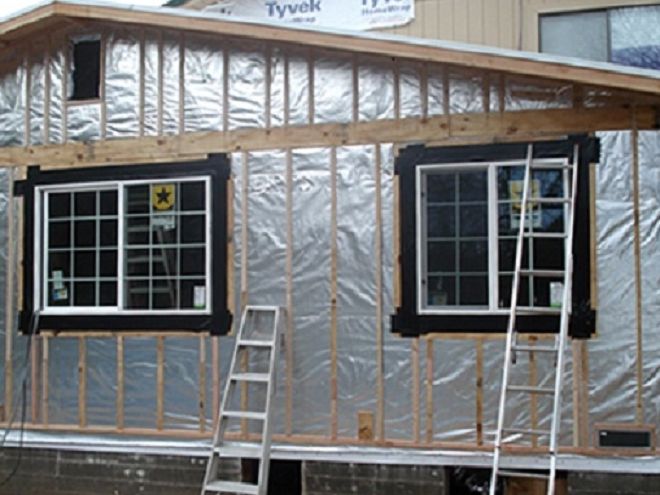

Installation of slabs over windproofing
A beam with a section of 40x40 mm is mounted to form a ventilated gap. If, according to the manufacturer's instructions, a step less (30 cm) is required for fastening the siding than for the frame racks (60–0.5 cm), a horizontal frame is preliminarily built, on top of which the racks for installing siding with a given pitch are attached.
Installation of siding may differ depending on the manufacturer, type of siding, direction of the planks. When selling material, official dealers and large networks of building materials always issue proprietary instructions for installing a specific type of material.
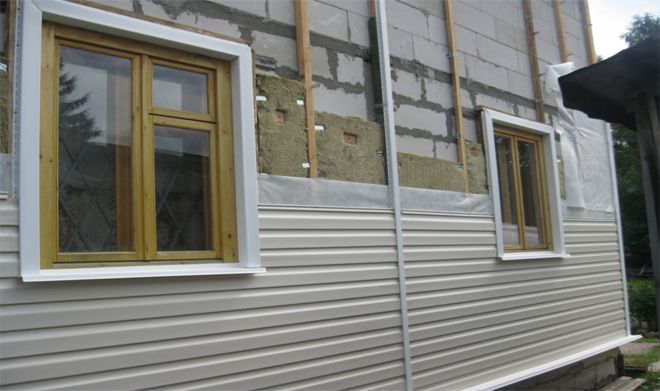

Installation of hydro and vapor barrier ↑
Roll materials are first freed from packaging, after which they are laid on top of the mounted sheathing from its inner side. This can be done in two ways. The first one is more preferable, since it provides a better seal. This method consists in unwinding the roll around the perimeter of the house and at the same time fastening the material. It fits from bottom to top: the first row is attached at the very bottom, and the next row is higher, with an overlap on the bottom. In this case, the joints are glued with adhesive tape.
For ease of use, a pole with a round stopper at the bottom is used to prevent the film from slipping. A roll of film is put on the pole: such a device simplifies the unwinding of the waterproofing.
The second method consists in unwinding the rolls from the upper level of the building downwards: the material is laid in vertical parallel rows. In this case, it is also necessary to observe the overlap and glue the joints of the rows.
Roof waterproofing, carried out using a similar material, should go with its lower edge over the film laid on the walls: this is necessary so that moisture from above can drain from the outside of the material. The vapor barrier material is attached from the inside in the same way, but only after the installation of thermal insulation boards.
After completing the installation of the waterproofing and vapor barrier film, you can start cladding the walls of the building with siding: the entry points of the self-tapping screws will not break the tightness, since they are screwed in from the outside.
Methods for laying waterproofing material
Rolled steam and waterproofing materials can be installed in two ways.
The first method is to unwind the roll and position the film horizontally. At the same time, it is fastened. The first row is fixed at the very bottom of the facade. The second is placed higher with an overlap of 150 mm to the lower. Scotch tape is used to glue the edges. This option is the most preferable because it provides sufficient tightness.
It is convenient to uncoil the roll using a pole. In its lower part, a limiter is attached to prevent the roll from sliding.
The second method consists in vertical laying of steam and hydro barriers.
With any method of installation, the waterproofing material used for the roof, with its lower edge, should go on top of the film laid on the walls.
We invite you to continue the topic of waterproofing for siding and post your comments and suggestions.
Waterproofing for siding - materials and stages of work, 4.4 out of 5 based on 14 ratings
izolyar.com
Do you need windscreens for siding?
Quite often, you can feel a sharp cold snap indoors. Most often this happens at a time when there is a strong gusty wind outside the window. This is especially true for the autumn period. To avoid discomfort, it is worth choosing the right insulating material.
A strong gusty wind can cause a cold snap indoors. Not all building materials can hold back the strong flow of cold air. Most often, such unpleasant situations occur in the autumn or spring. To combat this unpleasant situation, there is a windbreak film. This isolation is often neglected, but it is not always worth doing.
It is important to know ↑
Correct implementation of waterproofing and vapor barrier is an important condition for creating normal microclimatic conditions in a home. These materials are necessary to ensure high-quality wall insulation. Violations of the installation rules will lead to heat loss, dampness and mold. Expensive repairs will be required with the replacement of finishing materials. To prevent this, you should seek help from a specialized company whose specialists have sufficient experience.
Quite often, a sharp cold snap can be felt inside the room. Most often this happens at a time when there is a strong gusty wind outside the window. This is especially true for the autumn period. To avoid discomfort, it is worth choosing the right insulating material.
A strong gusty wind can cause a cold snap indoors. Not all building materials can hold back the strong flow of cold air. Most often, such unpleasant situations occur in the autumn or spring. To deal with this unpleasant situation, there is a windbreak film. This isolation is often neglected, but it is not always worth doing.
Siding used as a finishing material inside or outside the building unconditionally needs additional thermal insulation. However, whether special wind protection is needed for such a material, it is worthwhile to figure it out for sure, since its installation is associated with additional costs.
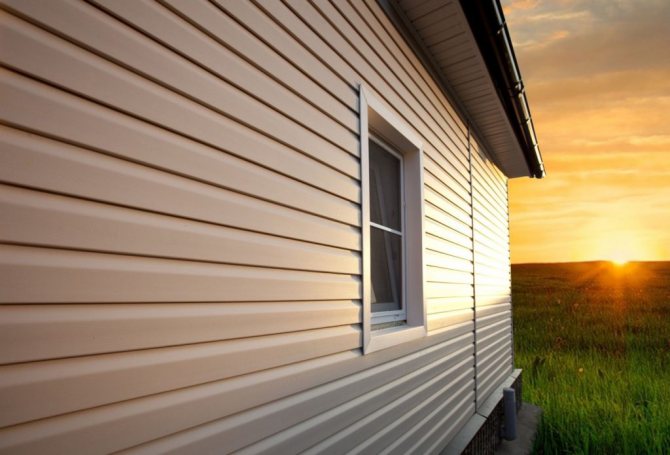

House finished with siding
As practice shows, most often siding - panels are often used as an external finishing material, during the reconstruction of old buildings. Often, it is in this way that old buildings are sheathed from timber, wood, and also brick. This method of reconstruction allows you to revive the building, giving it a modern stylish look.
It should be noted right away that siding panels do not have thermal insulation properties, which is why we can say with confidence that here you will have to work hard to create high-quality insulation.
Windscreen under siding - panels
During restoration work, it is safe to say that wind protection for siding is necessary. Its presence will help protect the quality properties of the thermal insulation layer.
If the insulation layer fully fulfills its functions, then the following indicators are immediately visible on the face:
- while maintaining the quality properties of the insulation, there is no need to constantly heat the premises in the building;
- the atmosphere inside the room cools down more slowly, which makes it much easier to maintain a certain temperature inside the room;
- in the presence of a high-quality insulation layer, you will protect the walls from possible freezing at low temperatures;
- among other things, excellent sound insulation performance is revealed.
Mineral wool is most often used as insulation for external walls. This insulation has remarkable properties, but its use requires high-quality waterproofing.Since the open ingress of moisture has a detrimental effect on the properties of any insulation.
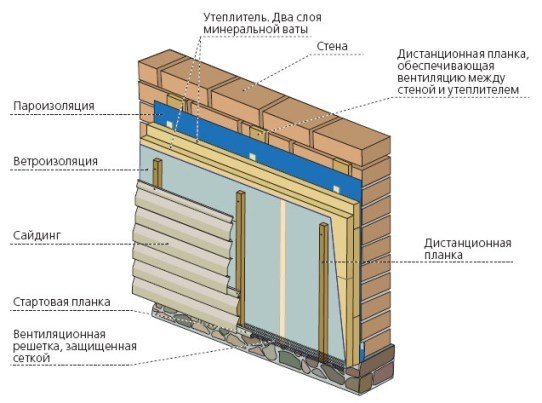

Wind protection scheme for siding panels
Very often, a waterproofing film includes a windproof layer, which eliminates the need to purchase additional material. However, not every waterproofing material differs with such properties.
When waterproofing wind, it is very important that individual pieces of material are overlapped, and the joints are glued with high quality using a special tape.
Windscreen has a short history of use. We can say that this is a new material that was specially developed for new facade materials with high ventilation rates. It should be said right away that in this case, you cannot do without special wind protection, otherwise, with strong gusts of cold wind, temperatures in the room will quickly drop.
Varieties of windproof films
There is a great abundance of insulation materials nowadays. This nuance was not spared by the side of wind protection, which in the modern market is presented in several types of performance, namely:
- Diffuse membranes. With the help of this material, not only waterproofing is performed, but also reliable protection of the insulation from wind load. In this case, the material consists of several layers. For better results, it is recommended to use three or four layer films. It is also worth noting that with the help of such material, vapor barrier for siding is also performed. Diffuse membranes are considered the most popular insulation material today.
- Windproof film. Many companies are engaged in the release of such products. This material is designed to withstand strong wind currents, being a reliable barrier to cold air. Such a film is characterized by resistance to heavy loads, which is why films with increased density are used as wind protection.
Wind bar
When cladding external walls with siding panels, it is important to pay attention to the wind slats. This element helps to contain loads from sudden gusts of wind. When using these elements, the façade siding coating wears out significantly less. This material allows you to significantly redistribute the load.
The use of a wind bar will not only significantly extend the life of the cladding, but will also give a complete look to the façade of the building. It is worth noting that, as in many other cases, the mounting of such elements is carried out with accurate calculations, in a strict sequence. Otherwise, the use of wind bars will not give the desired result.
Vapor permeability issue
The building wall in SNiP is described as a multi-layer enclosing structure. Interior decoration - wallpaper, for example, plaster, wall - monolithic, with voids, double, and external decoration - this is the simplest version of its device. If thermal insulation is assumed, the design becomes much more complicated.
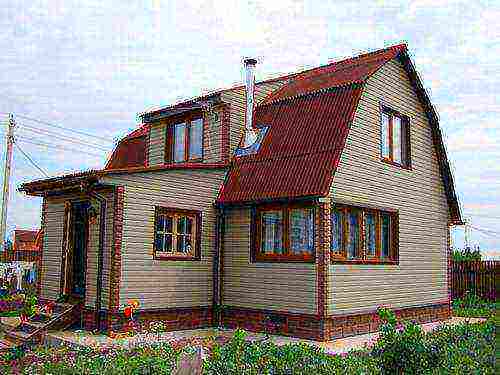

Obviously, the ratio of various materials in such a "pie" cannot be random and obeys a certain pattern. It sounds like this: the ability of the material to remove steam should increase from layer to layer from the inside out.
Why is this needed? In a residential building, a constant source of steam generation is not only a gas stove or water in a sink, but also people, animals and plants. The steam released by breathing or during washing and cooking is removed by means of a ventilation system or simply through an open window, but also through the walls of the building. If this does not happen, moisture accumulates in the room, and condensation falls on surfaces - walls, furniture, clothes.
- This case is best illustrated by a bathroom in a multi-storey building, where good ventilation is almost never possible.After taking a bath or even a shower, the entire room, from the ceiling to the handles on the washing machine, becomes wet. Why? The bathroom is finished with tiles or tiles, this material is completely vapor-permeable, and therefore moisture is not removed at all. The dew point is the fallout of condensation, it is located inside the dwelling on the walls.
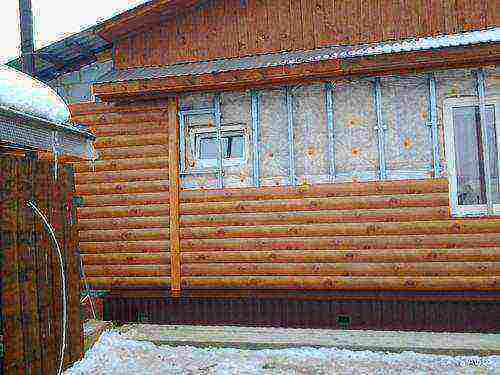

- Option two - thermal insulation inside. A solution that builders try their best to avoid. Compared to a brick wall, the vapor permeability of the insulation is much higher, therefore, in the structure - decoration / insulation / wall, the most vapor-permeable element is mineral wool or foam. Condensation falls out in the area of thermal insulation and quickly destroys the material, which makes waterproofing necessary.
- If the insulation is carried out outside, then the "cake" looks like this: wall / insulation / cladding, and, again, the dew point falls on the insulating layer, since the cladding absorbs moisture much less. To prevent this from happening, the insulation is protected with hydro and vapor barrier. Then the dew point is in the air gap between the wall and the insulation, for which, during installation, a solid ventilation gap is left here.
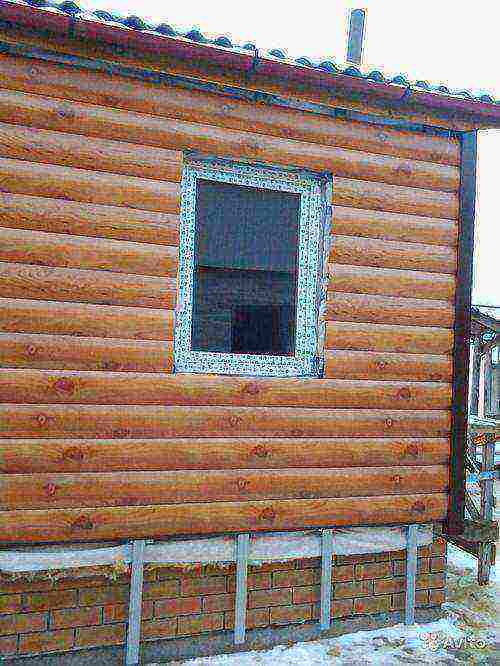

Installation of siding without insulation
- But if the walls of the building themselves have high thermal insulation characteristics - a brick wall of sufficient thickness, for example, then there is no need to additionally insulate them, but they need to be protected from wind and rain. Do you need waterproofing and wind protection for siding without insulation?
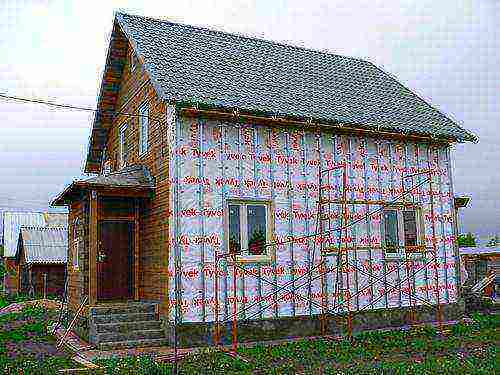

The design looks much simpler: wall / cladding. However, the vapor permeability of the wall is higher than that of both metal and vinyl finishes, that is, a violation of the rule to increase vapor permeability occurs and the dew point is in the zone between the wall and the finish.
To avoid moisture accumulation, a ventilation gap is left between the finish and the wall. Therefore, the installation of finishing without thermal insulation is quite possible, but without the crate it is not. If there is an air layer, then condensation accumulates on the inner surface of the finish, which is insensitive to water, if not, then directly on the wall, which leads to its destruction.
- Is waterproofing required here? It is not needed, since during sheathing, its task is to protect the insulator layer, which in this case is not used.
- Do you need a vapor barrier for siding without insulation? A vapor barrier or wind protection is a vapor-permeable membrane that allows steam to pass in both directions, and water only in one direction, from the heat-insulating layer. Again, if he is not there, then there is nothing to defend. Siding technology without insulation
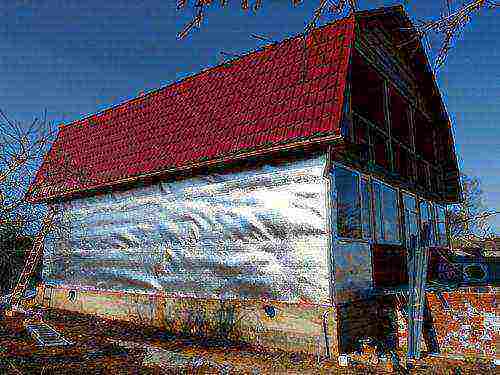

Installation without heat and vapor insulation is much easier.
- The facade surface is cleaned. The old finish, if any, must be removed. If it is supposed to sheathe a wooden house with siding without insulation, then it is worth digging up the cracks between a bar or a log before work - this procedure will significantly reduce heat loss.
- A crate is fixed on the surface - from a galvanized metal profile or a wooden bar treated with an antiseptic. The thickness of the timber should not be less than 50 mm, despite the installation without thermal insulation.
- The step between the frame elements, as well as the direction - vertical or horizontal, are determined by the type of siding - lamellas, panels, and the method of installation.
- The material is fixed to the crate in the usual way: first, the starting bar is fixed, then the corner elements and near-window frames, the connecting profiles are fixed, if necessary.
- Then a panel is inserted into the groove of the starting plate and fixed on the crate. The fastening is not rigid, the film for siding without insulation is not needed.
The photo shows one of the working moments.
In all honesty, it is better not to insulate houses made of solid wood at all. High-quality massive logs and beams, being preserved in their natural form, provide an optimal microclimate in the house.Wood, unlike most other wall materials, "breathes", this is one of its main advantages. However, in the case of insufficient thickness of the wooden walls, or if the house has already stood for many years and the logs need protection from external influences, external insulation and cladding are justified measures, helping to reduce heating costs and prolong the life of decaying wood. The most practical material for the exterior cladding of a wooden house is vinyl siding. It is inexpensive, its service life is half a century or more, it is easy to install, and it can be repaired without any problems. The siding house looks neat. We will tell you what should be the correct insulation of a wooden house for siding.
To improve thermal insulation without worsening the microclimate and without harming the structure, you need to understand the specifics of the construction and operation of a wooden house. Let's start with theory: a little about woodworking and a little building physics.
Wind protection and its properties for siding panels
As practice shows, this type of building insulation, such as wind protection, is extremely necessary to create comfortable and cozy conditions inside the building. Very often, it is precisely because of the sharp gusts of strong wind in living quarters that it is impossible to be without warm clothes.
As for siding panels, many people mistakenly think that air currents do not penetrate through it. This opinion is wrong. As practice shows, air flows are everywhere. Because of this, a simple siding cladding will not be enough, and you will need to install high-quality wind protection.
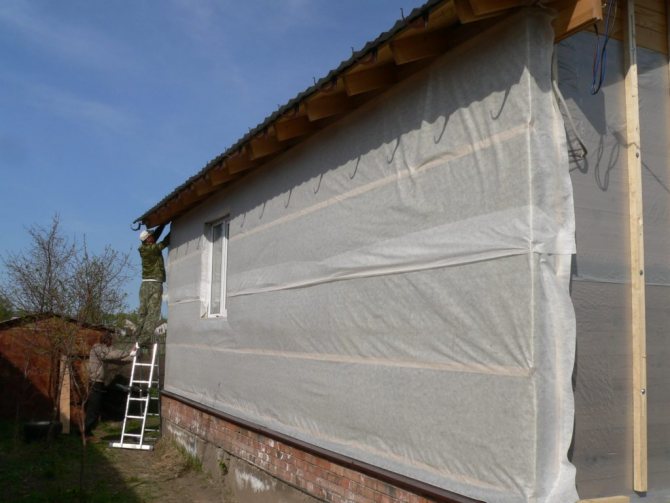

Windproof film attached to the facade of the house
Windscreen is a kind of membrane that acts as a barrier against sharp cold currents. This membrane is designed to contain external air currents, but it allows air from the inside. In the case of installation, the main thing is not to make a mistake and not install the film the other way around. Otherwise, it will be impossible to achieve comfortable conditions inside residential premises.
A well-installed wind insulation must have the following properties:
- Protection of the structure against possible moisture penetration.
- The windproof layer completely covers the entire surface of the walls, while closing possible gaps in the insulation.
- The surface of such a material should facilitate the removal of moisture, while not allowing moisture inside.
Waterproofing
Waterproofing is installed between the insulation and the siding - this is the protection of the insulation from the outside. It does not let moisture into the insulation. But through it water vapor freely passes from the insulation to the outside.
Most films require a gap of a few centimeters between them and the thermal insulation - only then will the waterproofing film work properly. But some types allow you to put them directly on the insulation (Izospan AM, Izospan AS, Tyvek).
If a wooden house does not need insulation, then waterproofing is mounted directly on the walls. It will protect the tree from condensation and keep it from getting wet and rotting.
We offer films for waterproofing:
- Yutafol D96 Silver
- very durable and inexpensive film; - Tyvek Soft, Solid
- single-layer membrane films create especially comfortable conditions in the living area; - Izospan A
- multi-layer waterproofing economy class, during installation, a gap between the film and the insulation is required; - Izospan AM and AS
- multilayer films, installation without a gap between the film and the insulation is possible.
Mounting the windbreak
When installing a windproof film, as in the case of a waterproofing layer, the film is overlapped. All joints that form must be glued with a special waterproofing tape. In this case, it is required to use just such a tape, this will protect the structure from the penetration of cold air.
When choosing a tape, do not forget that this material must have good vapor permeability. There should be no difficulty with the acquisition of such products, since such a building element is usually produced by the same manufacturer as the wind-waterproof film.
As for the overlap, for best performance, it is recommended to do it at least 15 centimeters.
The film material is sewn onto the finished frame, which makes an indent from the insulation by 2 - 3 centimeters. This gap is required for ventilation.
As it becomes clear, without high-quality wind protection, it is almost impossible to achieve comfortable living conditions. Its use is essential for almost any exterior wall covering. This material is used to isolate only private houses, since its use in multi-apartment buildings is difficult. As for the cladding of the building with siding panels, here you cannot do without the use of a windproof film.
Vapor barrier under siding: when and why you need it
When we are asked to calculate the cost of cladding a house with siding, we are often asked the question: “Have you counted the vapor barrier for siding?”.
At the same time, most often the customer does not understand what he is talking about. But this is fixable.
In this article, you will learn what vapor barrier is, what it is for and when it is necessary to vapor barrier under the siding.
What is vapor barrier
Vapor barrier is a non-woven material in the form of a film rolled into a roll.
In this photo, the first floor of the house is sheathed with a vapor barrier before insulation (click to see all photos from this object)
The simplest and most inexpensive vapor barrier is plastic wrap.
But there are also more advanced types: membranes with limited one-sided vapor transmission, etc.
The purpose of this article is not to describe all types of vapor barrier, but to help you figure out if a vapor barrier is needed when cladding your house with siding, so I will not go deep into the range of membranes and films.
Why do you need a vapor barrier in general and under siding in particular
As the name suggests, a vapor barrier isolates the vapor, creating a barrier to its movement from a warmer room to a colder one (outside).
If you allow steam (water in a gaseous state) to pass through the wall of your house, then at some point, the state will change and the gas (steam) will turn into liquid (water).
The place where water vapor condenses and turns into a liquid is called the dew point.
Typically, it is located somewhere inside the wall of your house.
If the steam is not allowed to "crawl" to the dew point, then it will never become moisture (liquid).
The location of the dew point depends on the difference in humidity and temperature between two rooms or between a room in your house and a street.
The warmer the house and the colder it is outside, the closer the dew point moves to the outer surface of the wall.
Once you cut off the outward movement of the vapor in the air inside your home, you protect it from liquidation (condensation) because it does not reach the dew point.
How condensation can damage your home
Residents of panel houses, most likely, faced humidification of the walls inside the house during the cold season.
This humidification occurs due to the dew point shifting into the interior of the house, and the vapor turns into liquid right on the wall.
More often than not, we do not see the condensation process, because the dew point is inside the wall.
But if you decide to insulate the house with siding, then the dew point shifts even further outward and will now be inside the insulation (especially if the insulation is thicker than 50 mm).
In the case of expanded polystyrene (polystyrene), this is not scary, because it itself is a vapor barrier and does not conduct steam.
But if you insulate the house under siding with mineral wool (mineral wool slabs), which have good vapor permeability, then condensation will form inside such a slab.
In other words, the insulation will get wet inside due to the temperature difference between the room and the outside.
Wet insulation is bad insulation.
Increase the moisture content of the insulation by only 5%, and its thermal insulation capacity becomes two times lower.
It is easy to understand this: the insulation under the siding with a thickness of 100 mm without vapor barrier heats the same way as 50 mm with vapor barrier.
If you do not make a vapor barrier, then you pay for insulation twice as much as you get.
By the way, we have a great article on mistakes when insulating. Click here: 5 mistakes when insulating a house under siding.
When you need a vapor barrier under the siding
As follows from the above, a vapor barrier is needed if you are insulating a house under siding when installing insulated siding.
In this photo you can see the insulation mounted on the vapor barrier (click to see all photos from this object)
In any other case, there is no point in vapor barrier, and you need a similar in appearance, but completely different material: windproofing or, as it is also called, windproofing.
If you insulate the house under siding, then you will still need wind protection.
It will close the insulation outside.
With proper insulation of the house with siding, a multi-layer cake is obtained: siding, under it there is windproofing, under it is an insulation, under it is a vapor barrier attached to the wall of the house.
The order of work when insulating a house with siding
So, you have decided that the walls of your house need to be insulated.
In what order is it done:
Installation of vapor barrier on the wall of the house
First, we protect the insulation from steam, which will penetrate into it from the inside of the house.
To do this, we mount the vapor barrier directly on the wall of the house, always with an overlap:
In this photo you can see a vapor barrier installed on a log house before insulation with siding (see all photos from this object: click here)
By the way, we have a great article on siding log houses. Click here: Timber House Siding.
Installation of insulation over vapor barrier
Next, we mount the insulation, for the sake of which the vapor barrier was started under the siding.
Now we can be calm: the insulation is reliably protected from moisture penetrating in the form of steam from the inside of the house.
In STK Etalon, insulation is carried out without cold bridges, which is one of the many advantages of ordering siding installation from us.
In this photo, the insulation has already been mounted on top of the vapor barrier, and pressed down by the first layer of the crate, but has not yet been closed with windproofing
Installation of windproofing (wind and moisture protection) over the insulation
Now we protect the insulation from moisture that can get into it from the outside and reduce its heat-insulating ability, for which we attached it to the wall.
We need to close the insulation with wind-water protection, it is also wind-water insulation, it is also wind and moisture protection.
In the photo, the insulation is covered with wind protection, which is fixed by the partially mounted second layer of the crate
Installation of siding on top of windproofing
All work on creating a warm “cake” is completed.
Now we cover all this with siding, and the house becomes warm and cozy, while its “subcutaneous fat” (insulation) is reliably protected from moisture on both sides.
See all photos from this property: click here
When is a vapor barrier under siding not needed?
One You already know the answer to these questions: if the house is not insulated, then vapor barrier is not needed (but wind protection is needed).
Second Answer: you will not need a vapor barrier under the siding (or, more precisely, under the insulation) if it is already on the walls of your house inside.
When is vapor barrier and waterproofing needed?
Vapor barrier is required in those structures where the vapor permeability of the wall and heat insulator is high.For example, when insulating a panel house with polyurethane foam, vapor barrier is not needed, and a forced ventilation system is required to remove water vapor, so as not to get high humidity in the house, and with it - mold and fungus. A brick house will already require a vapor barrier.
Pure waterproofing for siding is not needed at all. In order to prevent moisture vapor from the atmosphere from getting deep into the heat-insulating layer, a vapor barrier is needed. But in order for the condensate accumulated on it to be taken out, a ventilated gap with a width of at least 40 mm is arranged between the cladding and the insulation.
And here the second enemy of soft cotton insulation acts - the wind. The higher the building, the higher the wind speed in the ventilation gap, the sooner soft slabs and mats will loosen.
To prevent this from happening, the outer surface of the heat-insulating material is protected with a moisture-proof film or a more technological material - a special membrane. There are also heaters with a laminated outer surface - protected from weathering by a fabric or film layer in production.
Waterproofing for siding - materials and stages of work


Siding facade decoration is a popular solution in private low-rise construction. The use of siding allows you to protect from rain, wind, temperature changes and, at the same time, decorate cottages, outbuildings, garages or baths. This finishing material is easy to clean and retains its original appearance for a long time. To increase the heat-saving characteristics of the house, a layer of insulation is often laid under the siding. To protect the thermal insulation layer from getting wet, a waterproofing material is mounted on top of it. In the absence of insulation, waterproofing is still necessary.
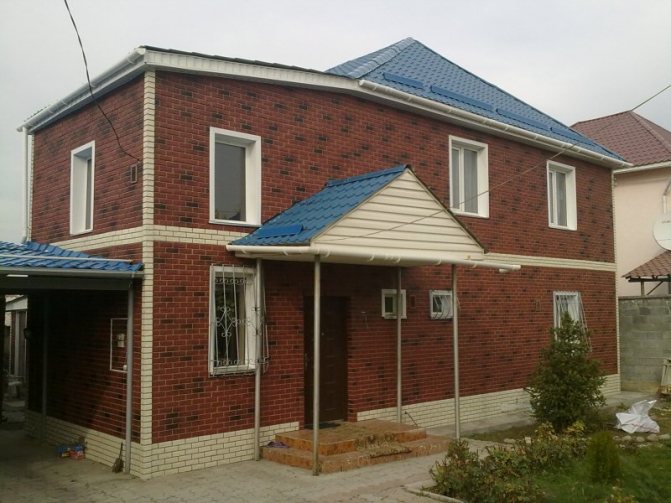

Siding successfully imitates popular decorative materials such as facing bricks or natural wood, but costs much less.
Functions of waterproofing under siding
Waterproofing materials laid under the outer skin are used to solve the following tasks:
- Vinyl or metal siding does not get wet, but a leaky connection of the panels causes moisture to enter the gaps, which leads to deformation of the insulation. Most often, mineral or glass wool is used as a heat insulator for siding. These are non-combustible, lightweight materials with excellent heat-saving characteristics. But when wet, they completely lose their performance. The moisture penetrating between the panels also damages the wall materials - drywall and wallpaper; using electrical appliances may become unsafe. When waterproofing is installed, moisture flows down without destroying the thermal insulation material and the wall structure.
- The snow piling up under the ridge of the roof gradually melts and flows down the walls. If a waterproofing material is mounted, moisture goes through it to the foundation blind area, then to the drainage system.
A high-quality waterproofing film retains moisture, but does not interfere with the natural ventilation of the walls, so steam from the house can escape.
In combination with waterproofing materials, a vapor barrier is often used to protect the insulation from steam coming from the house. Steam condenses and moisture penetrates the insulation. The vapor barrier is placed between the wall and the insulation.
Modern vapor barrier materials do not completely trap steam. To prevent the "greenhouse effect" in the house, a metered amount of air flow passes through the vapor barrier. Excess moisture is retained on the surface of the vapor barrier, and small amounts of dried air do not harm the insulation.
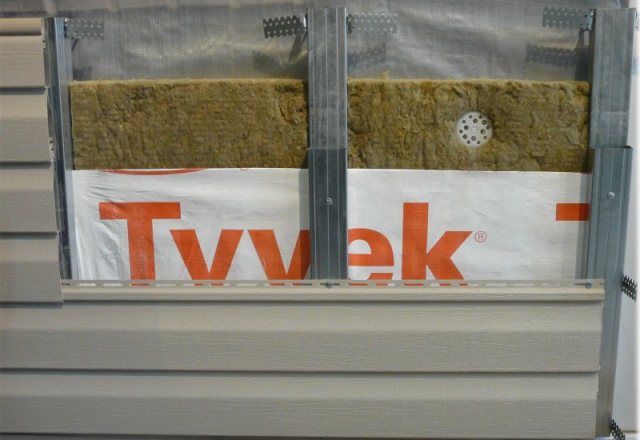

The need for a vapor barrier is determined by the type of thermal insulation material
Why waterproofing is necessary
Vinyl and basement siding provide good protection from rain.But the panels are leaking. Air passes freely through them, the house "breathes", and moisture enters with the air.
Modern heaters made of mineral and glass wool have excellent thermal insulation properties, are fireproof and lightweight. But they are afraid of water. When wet, they lose their qualities, become heavy and deformed.
Even if the facade cladding is carried out without insulation, then waterproofing is still needed - to protect the wall structures from getting wet.
Therefore, the installation of waterproofing is always required when decorating a house with siding.
Insulation under siding - the best options
Thermal insulation material is selected depending on the climate, the purpose of the house (for periodic or permanent residence), the presence of constant winds, and the level of humidity.
The following main types of insulation can be distinguished:
- Roll materials have a small thickness - up to 20 mm, are attached directly to the wall with adhesives, and are used in warm climates.
- The basis of mineral wool insulation is basalt, silicate fibers or fibers of other rocks. One of the varieties of such heat insulators is glass wool. Plates and mats made of such fibers are produced soft, semi-rigid, rigid. The materials have excellent heat-saving, sound-insulating characteristics, but a rather high coefficient of water absorption. Such heaters require packing on the vapor barrier wall before their installation.
For buildings constructed of completely vapor-tight materials, no vapor barrier is required for siding. But in this case, internal insulation is contraindicated, since the thermal insulation will definitely get wet.
- Polyfoam and extruded polystyrene foam have lower absorption than mineral wool.
Vapor barrier


The vapor barrier is installed between the wall and the insulation - this is the protection of the insulation from the inside. Such a film does not allow moisture or steam to pass through. Its task is to prevent steam from entering the insulation from inside the house.
How much steam is released from inside the premises? For example, one person releases up to 1.5 liters of water per day in the form of steam. Without a vapor barrier, more or less of this moisture (depending on the ventilation in the room) will be absorbed into the walls and into the insulation.
We offer vapor barrier films:
- Yutafol N96
- three-layer vapor barrier with a reinforcing mesh; - Izospan B, C
- two-layer vapor barrier with a rough reverse side - accelerates the evaporation of moisture; - Izospan D
- high-strength woven vapor barrier.
The procedure for installing siding with laying vapor barrier, insulation and waterproofing
Consider the stages of facade cladding with siding using the example of a wooden house and mineral wool insulation:
Some types of waterproofing materials additionally require compliance with the gap between the thermal insulation and the hydro-barrier.
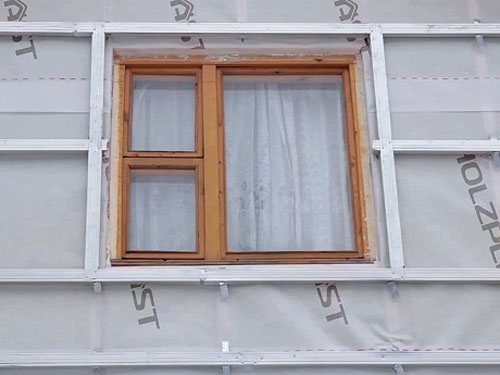

On top of the fixed waterproofing, a counter-lattice is mounted under the siding from a bar or metal profile, the second option is more durable and reliable
Types of windscreen
The protective properties of the outer "cake" of insulation depend on the effectiveness of the windbreak. You can choose a windscreen for siding from the options:
- polyethylene films;
- non-woven diffusion membranes;
- superdiffusion membranes.
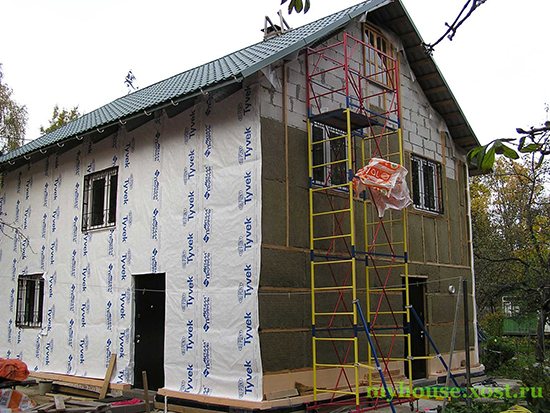

OLYMPUS DIGITAL CAMERA
Polyethylene films protect the insulation layer of the walls from precipitation and blowing. However, polyethylene is poorly permeable to steam and does not withstand strong temperature changes. The main advantage is affordable cost and waterproofing, the main disadvantage is the absence of pores, which often leads to the formation of condensate, which is detrimental to the insulation.
Non-woven diffuse membranes are a porous polymer-based material. Its pores do not let rain drops, but do not trap steam from the walls to the outside. This prevents the formation of condensation and protects the mineral wool from getting wet. Diffuse membranes are able to withstand strong gusts of wind, freezing air and high temperatures. They are non-toxic and non-flammable, which is the reason for their popularity.
Superdiffusion membranes are a variation on the previous material. They are also made from polymers in a non-woven way. The main difference is multilayer, which increases the water-repellent and windproof properties, while maintaining high vapor permeability. The use of superdiffusion membranes makes it possible to mount the windscreen without ventilation gaps.
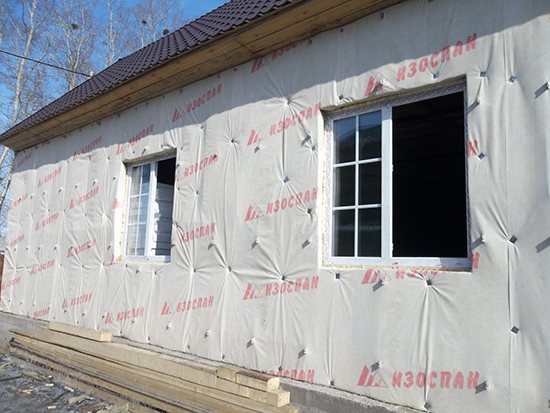

When choosing a material, it is also recommended to take into account the properties:
- tensile strength (the higher the better);
- water resistance;
- vapor permeability;
- withstand temperatures;
- resistance to ultraviolet radiation from the sun.
The windscreens are covered with siding to protect them from UV light, but the radiation-resistant materials can be used not only as windscreens, but also as temporary coverings.

